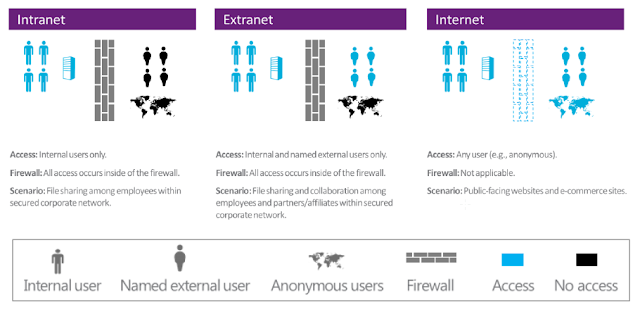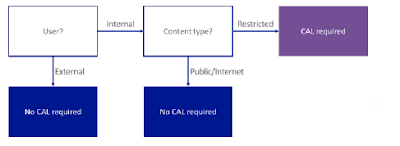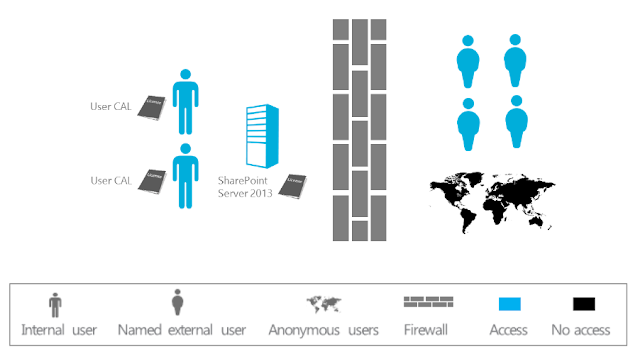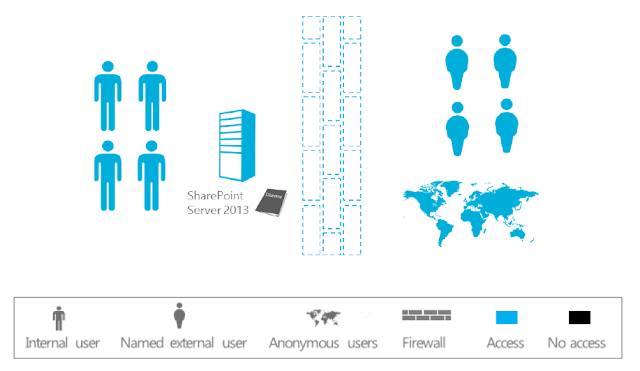Now again Microsoft has changed the paradigm of licensing with SharePoint 2013
Lets have a look, how it works now. This content has been taken from a Microsoft document which might change in future, Please contact Microsoft licensing team before taking any final decisions on licensing part.
Concepts that Provide a Framework for SharePoint Server Licensing
Internal Users: Users who are the licensee’s or its affiliates’ employees and on-site agents and contractors.
External Users: Users who are not the licensee’s or its affiliates’ employees or on-site agents or contractors.
Intranet: Website hosting content, information, or software that is accessible inside the firewall to internal users only.
Extranet: Website hosting content, information, or software that is accessible inside the firewall to internal users and named external users only.
Internet: Website hosting content, information, or software that is publicly accessible to all users (internal and external).
Microsoft SharePoint Server 2013 Licensing
Microsoft licenses SharePoint Server 2013 under the Server/Client Access License (CAL) licensing model. The Server/CAL licensing model requires both a server license for each copy of the server software a customer installs and uses and CALs for the users (or devices) that access that software. CAL requirements vary based on user status, and CALs are generally required for internal users to access all SharePoint Server software. An exception to this is internal user access to Internet websites (public-facing websites such as e-commerce sites). In this case, the SharePoint CAL requirement is waived. In contrast to the general requirement for CALs for internal user access, CALs are not required for external users to access SharePoint Server. In other words, the server license provides access rights for external users. The same criteria can be used for determining when CALs are required for SharePoint base CALs and Enterprise CALs; however, SharePoint Enterprise CALs are required only if functionality corresponding to the SharePoint Enterprise CAL is accessed. For more information about which SharePoint features are part of the base product and which features are considered additional functionality requiring additive CALs, refer to http://technet.microsoft.com/en-us/library/jj819267.aspx
Or
The following decision tree illustrates whether a user needs a SharePoint CAL or not. “Restricted” refers to content stored inside the firewall for internal access and possibly limited, identified external user access. “Public/Internet” refers to content stored outside the firewall for broad, unrestricted access.
User Scenarios
This document also illustrates common deployment scenarios to further explain the licensing requirements of SharePoint Server 2013. Users can license these same deployment scenarios under device-based CALs.
Scenario A: Intranet
Description: Internal users accessing content, information, or applications inside the firewall through a local area network (LAN) or the Internet. No other users have access.
Example: A professional sports team sets up an intranet site that the manager, coach, and players access. It is also used for support staff such as the physiotherapist who is an on-site contractor rather than an employee, and for CAL requirements, an internal user. A news reporter trying to access the SharePoint Server site is denied access.
Licensing:
Server: One SharePoint Server 2013 license per running instance of the software.
Internal Users: One CAL/user.
Scenario B: Extranet
Description: An organization extends access to otherwise restricted content inside the firewall to a limited number of identifiable external users.Example: The Elm University publishes research papers that are available to specific educators from other universities (external users). This situation is an intranet plus extranet scenario.
Licensing:
Server: One SharePoint Server 2013 license per running instance of the software.
Internal Users: One CAL/user.
External Users: SharePoint CALS are not required; the server license permits external user access.
Scenario C: Internet
Description: Internal users make content, information, and applications publicly available to users via the Internet (for example, on a public-facing company website). A mix of internal and external users anonymously accesses the site, including employees. No SharePoint CALs are required. External user access is permitted under the server license, and SharePoint CAL requirements for internal users are waived for access to content, information, and applications made publicly available via the Internet.Licensing:
Server: One SharePoint Server 2013 license per running instance of the software.
Internal Users: CALs are not required.
External Users: CALs are not required.
In Figure 5, access is unrestricted. The only license required is the server license. SharePoint CALs are not required to access content, information, and applications made publicly available to users via the Internet (that is, not restricted to intranet or extranet scenarios). The same licensing applies for an e-commerce site where access is not strictly anonymous. Again, SharePoint CALs are not required to access content, information, and applications made publicly available to users via the Internet.





